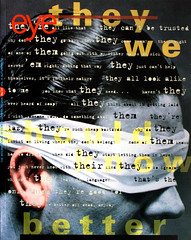Autumn 1994
All we lack now are the clients
14th Warsaw International Poster Biennale
Wilanow Poster Museum, Warsaw<br>4 June to 20 September 1994Set up in 1966, the Warsaw International Poster Biennale was the first major international showcase for posters. Yet four years ago, when briefly under the direction of the Galerie Zacheta (National Gallery of Contemporary Art), it was chased out of the site where it had been held for a quarter of a century and effectively suppressed because the authorities considered the poster – along with other works printed on paper – a bastard art, preferring a return to safe values in the form of painting and sculpture. Now, after two years of petitions and a change of management, the Biennale has started up again in a new location: the Wilanów Poster Museum, a department of the National Museum. The recently restored setting is brazenly modern and is expanding thanks to government funding – a good omen for the future of the Biennale. In addition, this year a number of parallel events were organised throughout the city, including a retrospective of the work of Roman Cieslewicz, an exhibition of travel posters and a symposium on ‘The Poster: Ad of Art?’
The Biennale is traditionally organised as a competition, with prizes awarded on the opening day of an exhibition of selected entries. The 14th Biennale attracted 1,877 entries by 275 graphic designers from 51 countries. After a preselection round, 475 posters were presented to an international jury of eight, including three members from Poland. The logic behind the categories is unclear, however: the ‘commercial’ category, for instance, includes the promotion of culture and art, while the ‘ideological’ category covers universal themes. Selection was made more difficult by the fact that there was a greater number of entries in the first category than in any of the others.
The jury awarded the gold medal in the ‘ideology’ section to a poster-designer’s poster – the ‘Blessing of Light’, a multicoloured moirage by Mitsuo Katsui of Japan. The apparent message: it does not matter if a poster addresses only a limited circle of initiates. This attitude points not so much to the death of the poster as to a general trend towards narcissistic academism.
The Biennale has posters that are impossible to understand without an explanatory caption – as at an art degree show – a celebration of aestheticism that shows the dead end certain schools have reached, particularly in Japan, where the poster is the graphic designer’s instrument of self-promotion, its content nothing more than a virtuoso demonstration of computer and print techniques.
Equally revealing are the themes addressed. Posters no longer sell products, but ideas. Many plead for good causes – world peace, AIDS prevention, helping the homeless, ecology, anti-racism, and so on. Liberated from the constraints fo advertising, this type of creative poster comes in a variety of styles: typographical games, photomontage, illustration. But while it may be easy to recognize the affiliations – French, Polish, or Californian school – the characteristics of individual works tend to blur.
This Biennale highlights an international phenomenon. On the street, it is the direct, photography-based advertising poster which dominates, yet such posters do not generate commissions for their designers. At the same time, ‘creative’ posters, with less street presence, are increasingly seen as a sound investment by collectors, museums and art publishing houses. Faced with a scarcity of commissions, designers are embarking on adventures of their own making, using the poster as the witness of our times, developing a graphic language to promote an ideology or to protest against the established order. The poster, the art of the street, is becoming internalised, in danger of being put under glass like a precious object. This exaggerated aestheticism obscures the essential role of the poster, which is to inform.
The Biennale allows an exchange of ideas, provides the opportunity for people within the profession to meet, and plays an essential role in maintaining the poster as an important part of our international cultural heritage. And the high standard of the entries allows the formation and promotion of an avant-garde of visual communication. It seems that the poster flourishes when it has a precise role – at present, in the service of good causes. There is no shortage of designers; what we do not have are the clients.
Margo Rouard-Snowman, author of Roman Cieslewicz (Thames & Hudson), Paris and London
First published in Eye no. 14 vol. 4, 1994
Eye is the world’s most beautiful and collectable graphic design journal, published quarterly for professional designers, students and anyone interested in critical, informed writing about graphic design and visual culture. It is available from all good design bookshops and online at the Eye shop, where you can buy subscriptions and single issues.

